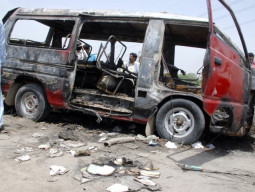
ISLAMABAD:
An official inquiry into the May 25 school van tragedy in Gujrat shows that the vehicle involved in the incident was in violation of a number of road regulations.
A three-judge bench of the Supreme Court, headed by Chief Justice Iftikhar Muhammad Chaudhry, was informed on Wednesday that the van had no fitness certificate and route permit. Its original diesel engine had also been replaced with a petrol engine to make it run on CNG without fulfilling legal requirements.
An inquiry conducted by the Gujranwala commissioner has blamed the secretary of Gujrat’s regional transport authority, motor vehicle examiner, district traffic police, excise and taxation department and education department for the incident, Punjab’s Additional Advocate General Jawwad Hassan told the bench.
The bench was hearing a suo motu case about the May 25 incident when 18 pupils – aged between five and 15 – of a private school and their teacher died when their van caught fire on their way to school.
The bench took exception to the fact that the police had not so far arrested any official of the Punjab government and observed that criminal action should be initiated against the officials responsible.
Gujrat’s District Police Officer Tahir Khan Khattak informed the bench that the driver and owner of the van, the school owner and the fitter of the CNG kit and cylinder in the van had been arrested.
The Punjab transport secretary’s statement that the van’s last fitness certificate expired on April 3, 2013 further alarmed the bench.
“It has been learnt that more than one CNG cylinders are fitted in passenger wagons and that too under the passenger seats. The passengers are sitting on bombs and the authorities have been unaware and unmoved,” Justice Chaudhry remarked.
He directed the Ogra chairman to appear in person and explain the policy of the federal government vis-a-vis fitness of the CNG equipment used in public transport and the precautionary measures taken in this regard.
Published in The Express Tribune, June 6th, 2013.
COMMENTS (2)
Comments are moderated and generally will be posted if they are on-topic and not abusive.
For more information, please see our Comments FAQ




























































It was very much need move (Sue Moto) by Supreme Court.
It is surprising to see that there is something called as "fitness certificate" in our country. Looking at the general condition of the passenger buses and vans particularly in the rural areas no one can ever imagine the presence "fitness certificate". If the fitness certificate expired in April that means a year ago the vehicle was fit for public transport and the CNG cylinders were placed roughly within a year. This alone doesn't look correct because for over a year there is a massive shortage of CNG.
Therefore, why one shall invest massive chunk of money in replacing diesel engine with petrol and then install CNG which has low availability. This shows how corrupt our system is. There must have been a set rate (no one like to call it a bribe anymore) to get the fitness certificate.
In rural areas there is another non-sense vehicle which is fabricated by local mechanics and is powered by Peter Engine - the diesel engine which is used in tube wells. That vehicle is a death machine. There is no registration on the vehicle but you see them all over. How can they operate unless local police is getting their fare share.
Court should also look into this and safeguard citizens from those death traps.
this is good SC is taking care of this. we strongly condemn this situation. there should be such action that no one dares to use faulty kits and cylinders again. van driver and owner should be hanged on the same spot the incident happened. officials involved should be sent to life time prison.